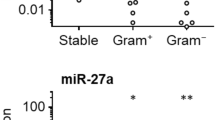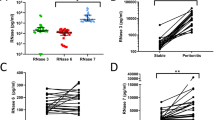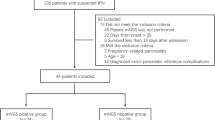Abstract
Background
Cell-free DNA (cfDNA) is present in the peritoneal effluent of stable peritoneal dialysis (PD) patients, but there are no data on cfDNA in PD patients with peritonitis. We investigated the variation of peritoneal cfDNA levels subsequent to peritonitis in PD patients.
Methods
We enrolled 53 PD patients: 30 without any history of systemic inflammation or peritonitis in the last 3 months (group A) and 23 with acute peritonitis (group B). CfDNA was quantified in the peritoneal effluent. Peritoneal samples on days 1, 3, 10, 30 and until day 120 from the start of peritonitis were collected for white blood cells (WBC) count and cfDNA evaluation in group B.
Results
Quantitative analysis of cfDNA showed significantly higher levels in group B on day 1, 3, 10 and 30 compared with group A (p < 0.05). A significant positive correlation was observed between cfDNA concentration and WBC on day 1 (rho = 0.89) and day 3 (rho = 0.5) (both, p < 0.05). However, no significant correlation was observed between cfDNA and WBC on days 10 and 30. In group B, peritoneal cfDNA levels tended to progressively decline during follow-up of peritonitis. From this decreasing curve, we estimated that 49 days are necessary to reach the value of 51 genome equivalents (GE)/ml (75th percentile in controls) and 63 days to reach 31 GE/ml (median).
Conclusion
Our results demonstrate that cfDNA increases in peritoneal effluent of PD patients with peritonitis and tends to progressively decline in step with peritonitis resolution and membrane repair process. Peritoneal cfDNA quantification could be an innovative method to determine acute damage and an inverse index of the repair process.




Similar content being viewed by others
References
Li PK, Szeto CC, Piraino B, Bernardini J, Figueiredo AE, Gupta A, Johnson DW, Kuijper EJ, Lye WC, Salzer W, Schaefer F, Struijk DG (2010) Peritoneal dialysis-related infections recommendations: 2010 update. Perit Dial Int 30:393–423
Piraino B, Bailie GR, Bernardini J, Boeschoten E, Gupta A, Holmes C, Kuijper EJ, Li PK, Lye WC, Mujais S, Paterson DL, Fontan MP, Ramos A, Schaefer F, Uttley L (2005) Peritoneal dialysis-related infections recommendations: 2005 update. Perit Dial Int 25:107–131
Brown EA (2005) Peritonitis: limiting the damage. Nephrol Dial Transplant 20:1539–1541
Lai KN, Leung JC (2010) Inflammation in peritoneal dialysis. Nephron Clin Pract. 116:c11–c18
Aroeira LS, Aguilera A, Sanchez-Tomero JA, Bajo MA, del Peso G, Jimenez-Heffernan JA, Selgas R, Lopez-Cabrera M (2007) Epithelial to mesenchymal transition and peritoneal membrane failure in peritoneal dialysis patients: pathologic significance and potential therapeutic interventions. J Am Soc Nephrol 18:2004–2013
Lam MF, Leung JC, Lo WK, Tam S, Chong MC, Lui SL, Tse KC, Chan TM, Lai KN (2007) Hyperleptinaemia and chronic inflammation after peritonitis predicts poor nutritional status and mortality in patients on peritoneal dialysis. Nephrol Dial Transplant 22:1445–1450
Lichtenstein AV, Melkonyan HS, Tomei LD, Umansky SR (2001) Circulating nucleic acids and apoptosis. Ann NY Acad Sci 945:239–249
Stroun M, Lyautey J, Lederrey C, Olson-Sand A, Anker P (2001) About the possible origin and mechanism of circulating DNA apoptosis and active DNA release. Clin Chim Acta 313:139–142
Atamaniuk J, Kopecky C, Skoupy S, Saemann MD, Weichhart T (2012) Apoptotic cell-free DNA promotes inflammation in haemodialysis patients. Nephrol Dial Transplant 27:902–905
Jung K, Fleischhacker M, Rabien A (2010) Cell-free DNA in the blood as a solid tumor biomarker–a critical appraisal of the literature. Clin Chim Acta 411:1611–1624
Pajek J, Kveder R, Gucek A, Skoberne A, Bren A, Bucar M, Cerne D, Lukac-Bajalo J (2010) Cell-free DNA in the peritoneal effluent of peritoneal dialysis solutions. Ther Apher Dial. 14:20–26
Korabecna M, Pazourkova E, Horinek A, Rocinova K, Tesar V (2013) Cell-free nucleic acids as biomarkers in dialyzed patients. J Nephrol. 26:1001–1008
Peters DL, Pretorius PJ (2011) Origin, translocation and destination of extracellular occurring DNA–a new paradigm in genetic behaviour. Clin Chim Acta 412:806–811
Atamaniuk J, Hsiao YY, Mustak M, Bernhard D, Erlacher L, Fodinger M, Tiran B, Stuhlmeier KM (2011) Analysing cell-free plasma DNA and sle disease activity. Eur J Clin Invest 41:579–583
Atamaniuk J, Ruzicka K, Stuhlmeier KM, Karimi A, Eigner M, Mueller MM (2006) Cell-free plasma DNA: a marker for apoptosis during hemodialysis. Clin Chem 52:523–526
Korabecna M, Opatrna S, Wirth J, Rulcova K, Eiselt J, Sefrna F, Horinek A (2008) Cell-free plasma DNA during peritoneal dialysis and hemodialysis and in patients with chronic kidney disease. Ann NY Acad Sci 1137:296–301
Opatrna S, Wirth J, Korabecna M, Sefrna F (2009) Cell-free plasma DNA during hemodialysis. Ren Fail 31:475–480
Ozkaya O, Bek K, Bedir A, Acikgoz Y, Ozdemir T (2009) Plasma cell-free DNA levels in children on peritoneal dialysis. Nephron Clin Pract. 113:c258–c261
Dwivedi DJ, Toltl LJ, Swystun LL, Pogue J, Liaw KL, Weitz JI, Cook DJ, Fox-Robichaud AE, Liaw PC (2012) Prognostic utility and characterization of cell-free DNA in patients with severe sepsis. Crit Care 16:R151
Baroni G, Schuinski A, de Moraes TP, Meyer F, Pecoits-Filho R (2012) Inflammation and the peritoneal membrane: causes and impact on structure and function during peritoneal dialysis. Mediators Inflamm 2012:912595
Catalan MP, Reyero A, Egido J, Ortiz A (2001) Acceleration of neutrophil apoptosis by glucose-containing peritoneal dialysis solutions: role of caspases. J Am Soc Nephrol 12:2442–2449
Wang HH, Li PC, Huang HJ, Lee TY, Lin CY (2011) Peritoneal dialysate effluent during peritonitis induces human cardiomyocyte apoptosis by regulating the expression of gata-4 and bcl-2 families. J Cell Physiol 226:94–102
Rhodes A, Wort SJ, Thomas H, Collinson P, Bennett ED (2006) Plasma DNA concentration as a predictor of mortality and sepsis in critically ill patients. Crit Care 10:R60
Saukkonen K, Lakkisto P, Varpula M, Varpula T, Voipio-Pulkki LM, Pettila V, Pulkki K (2007) Association of cell-free plasma DNA with hospital mortality and organ dysfunction in intensive care unit patients. Intensive Care Med 33:1624–1627
Saukkonen K, Lakkisto P, Pettila V, Varpula M, Karlsson S, Ruokonen E, Pulkki K (2008) Cell-free plasma DNA as a predictor of outcome in severe sepsis and septic shock. Clin Chem 54:1000–1007
Conflict of interest
No authors have reported a conflict of interest.
Ethical approval
This study was performed in accordance with the Declaration of Helsinki. The protocol and consent form were approved by the Ethics Committee of San Bortolo Hospital (Del.n.327, 8/2014).
Author information
Authors and Affiliations
Corresponding author
Rights and permissions
About this article
Cite this article
Virzì, G.M., Milan Manani, S., Brocca, A. et al. Peritoneal Cell-free DNA: an innovative method for determining acute cell damage in peritoneal membrane and for monitoring the recovery process after peritonitis. J Nephrol 29, 111–118 (2016). https://doi.org/10.1007/s40620-015-0212-2
Received:
Accepted:
Published:
Issue Date:
DOI: https://doi.org/10.1007/s40620-015-0212-2




